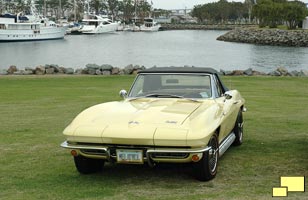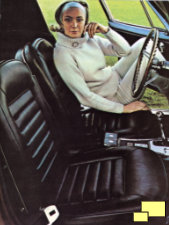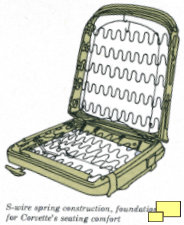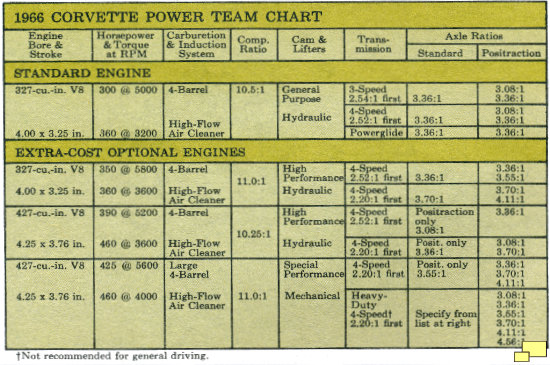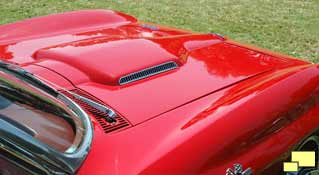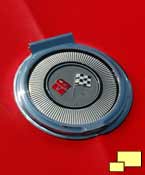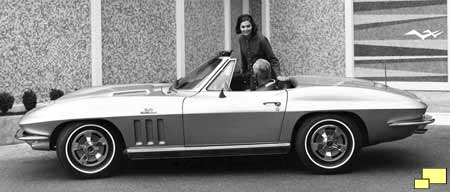Corvette Generations:
C1 C2 C3 C4 C5 C6 C7 C8
Corvette: Year by Year
1953 1954 1955 1956 1957 1958 1959 1960 1961 1962 19631964 1965 1966 1967 1968 1969 1970 1971 1972 1973 1974
1975 1976 1977 1978 1979 1980 1981 1982 1983 1984 1985
1986 1987 1988 1989 1990 1991 1992 1993 1994 1995 1996
1997 1998 1999 2000 2001 2002 2003 2004 2005 2006 2007
2008 2009 2010 2011 2012 2013 2014 2015 2016 2017 2018
2019 2020 2021 2022 2023 2024 2025
1966 Corvette C2 Stingray:
The Year of the Big Blocks
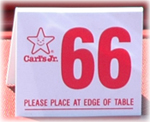 Big block engines dominated the Corvette Stingray story for 1966. They first appeared in April 1965 and as such had limited exposure. 1966 extended the big block Corvette story with the introduction of the legendary 427 cu. in. motors. They were bored and stroked versions of the 396 cu. in. 1965 big block motors and were available in two flavors: 390 hp (RPO L36, $181.20) and 425 hp (RPO L72, $312.85). The extra cost for the L72 was justified as it included four bolt mains, impact extruded aluminum pistons, a very aggressive camshaft, Holly 780 CFM carburetor mated to a aluminum intake and a free-flowing exhaust. The K66 transistorized ignition was a mandatory option with the L72. There are reports that the L72 actually featured more horsepower than the 450 hp that was quoted. The specifications were downgraded to avoid undesirable backlash from safety legislation, but enthusiasts only had to read the magazine reviews to learn what was really going on.
Big block engines dominated the Corvette Stingray story for 1966. They first appeared in April 1965 and as such had limited exposure. 1966 extended the big block Corvette story with the introduction of the legendary 427 cu. in. motors. They were bored and stroked versions of the 396 cu. in. 1965 big block motors and were available in two flavors: 390 hp (RPO L36, $181.20) and 425 hp (RPO L72, $312.85). The extra cost for the L72 was justified as it included four bolt mains, impact extruded aluminum pistons, a very aggressive camshaft, Holly 780 CFM carburetor mated to a aluminum intake and a free-flowing exhaust. The K66 transistorized ignition was a mandatory option with the L72. There are reports that the L72 actually featured more horsepower than the 450 hp that was quoted. The specifications were downgraded to avoid undesirable backlash from safety legislation, but enthusiasts only had to read the magazine reviews to learn what was really going on.

GM document with 1966 Corvette information, including Powertrain availability, features, specifications, transmissions, engine detail, body features, chassis specs and optional equipment.
Above: The "Corvette Sting Ray" script was revised to a more vertically elongated style for 1966.
For 1966 only it appeared on the hood front driver's side in addition to the right rear.
For 1966 only it appeared on the hood front driver's side in addition to the right rear.
Notification of the engine displacement appeared on the front fenders.
GM, per the 1966 brochure, was rightfully proud of the four wheel disk brakes which first appeared on the 1965 Corvette.
Corvette C2 seating was quite comfortable, definitely more so than the C1, and, some would argue, better than the early C3 seats.
Drivetrain choices were nicely varied in 1966. Notice the number of axle ratios available, quite a contrast to later years when regulations would effectively limit the number of options. The "Not recommended for general driving" refers to the famous M22 "Rock Crusher" Muncie four speed transmission. The M22 was exceptionally strong but, due to its straighter cut gears, had an audible whine.
Left: GM was always proud of the "Bang for the Buck" aspect of the Corvette; it would be a constant theme in their marketing efforts. Right: 1966 Corvette convertible on display at Carmel-By-The-Sea California.
Left: Zora Arkus Duntov, Corvette Chief Engineer, next to a 1966 Corvette, a highlight of his career.
 Left: Teak steering wheel was a handsome option (RPO N32, $47.40) that was first available in 1965. Middle: As in 1965, the "Bubble" hood signified a big block was lurking beneath. Above Right: Stylish emblem on the rear deck also functioned as a lid for fuel fill-up access.
Left: Teak steering wheel was a handsome option (RPO N32, $47.40) that was first available in 1965. Middle: As in 1965, the "Bubble" hood signified a big block was lurking beneath. Above Right: Stylish emblem on the rear deck also functioned as a lid for fuel fill-up access.
Right: Sample 1966 Corvette window sticker. A price of $5308.90 might seem like an amazing bargain these days, but in 1966 it was big $$$ and almost three times the price of an economy car.
Vent located between the speaker grill and the clock indicates an air conditioned C2 Corvette. The option was first available in 1963 (RPO C60, $421.80) when only 278 or 0.58% were so equipped. It got to be more popular in 1966 when 3,520 (12.70%) Corvettes included AC.
1966 Corvette: Official GM Photo.
1966 Corvette Options, Prices
| RPO | Description | Production | Price |
| Genuine Leather Seats | 2,002 (7.22%) | $79.00 | |
| A01 | Soft Ray Tinted Glass, all windows | 11,859 (42.78%) | $15.80 |
| A02 | Soft Ray Tinted Glass, windshield | 9,270 (33.44%) | $10.55 |
| A31 | Power Windows | 4,562 (16.46%) | $57.95 |
| A82 | Headrests | 1,033 (3.73%) | $42.15 |
| A85 | Shoulder Belts | 37 (0.13%) | $26.35 |
| C07 | Auxiliary Hardtop (for convertible) | 8,463 (30.53%) | $231.75 |
| C48 | Heater and Defroster Deletion (credit) | 54 (0.19%) | n/a |
| C60 | Air Conditioning | 3,520 (12.70%) | $412.90 |
| F41 | Special Front and Rear Suspension | 2,705 (9.76%) | $36.90 |
| G81 | Positraction Rear Axle, all ratios | 24,056 (86.78%) | $42.15 |
| J50 | Power Brakes | 5,464 (19.71%) | $42.15 |
| J56 | Special Heavy Duty Brakes | 382 (1.38%) | $342.30 |
| K19 | Air Injection Reactor | 2,380 (8.59%) | $44.75 |
| K66 | Transistor Ignition System | 7,146 (25.78%) | $73.75 |
| L36 | 427 cu. in. 390hp Engine | 5,116 (18.46%) | $181.20 |
| L72 | 427 cu. in. 425hp Engine | 5,258 (18.97%) | $312.85 |
| L79 | 327 cu. in. 350hp Engine | 7,591 (27.38%) | $105.35 |
| M20 | 4-Speed Manual Transmission | 10,837 (39.09%) | $184.35 |
| M21 | 4-Speed Man Transmission, close ratio | 13,903 (50.16%) | $184.35 |
| M22 | 4-Speed Man Transmission, close ratio, heavy duty | 15 (0.05%) | $237.00 |
| M35 | Powerglide Automatic Transmission | 2,401 (8.66%) | $194.85 |
| N03 | 36 Gallon Fuel Tank (for coupe) | 66 (0.24%) | $198.05 |
| N11 | Off Road Exhaust System | 2,795 (10.08%) | $36.90 |
| N14 | Side Mount Exhaust System | 3,617 (13.05%) | $131.65 |
| N32 | Teakwood Steering Wheel | 3,941 (14.22%) | $47.40 |
| N36 | Telescopic Steering Column | 3,670 (13.24%) | $42.15 |
| N40 | Power Steering | 5,611 (20.24%) | $94.80 |
| P48 | Cast Aluminum Knock-Off Wheels (5) | 1,194 (4.31%) | $316.00 |
| P92 | Whitewall Tires, 7.75x15 (rayon cord) | 17,969 (64.82%) | $31.30 |
| T01 | Goldwall Tires, 7.75x15 (nylon cord) | 5,557 (20.05%) | $46.55 |
| U69 | AM-FM Radio | 26,363 (95.10%) | $199.10 |
| V74 | Traffic Hazard Lamp Switch | 5,764 (20.79%) | $11.60 |
|
Total Production:
27,720
Notes: Base Corvette Coupe with 327 cu. in. 300 hp engine and three speed manual transmission: $4,295.00. |
|||
Colors
| Code | Exterior | Quantity | Interior | Soft Top | Wheels |
| 900 | Tuxedo Black | 1,190 (4.29%) | Black / Red / Bright Blue / White-Blue / Saddle / Silver / Green / Blue | Black / White / Beige | Black |
| 972 | Ermine White | 2,120 (7.65%) | Black / Red / Bright Blue / White-Blue / Saddle / Silver / Green / Blue | Black / White / Beige | Black |
| 974 | Rally Red | 3,366 (12.14%) | Black / Red | Black / White / Beige | Black |
| 976 | Nassau Blue | 6,100 (22.01%) | Black / Bright Blue / White-Blue / Blue | Black / White / Beige | Black |
| 978 | Laguna Blue | 2,054 (7.41%) | Black / Bright Blue / Blue | Black / White / Beige | Black |
| 980 | Trophy Blue | 1,463 (5.28%) | Black / Bright Blue / Blue | Black / White / Beige | Black |
| 982 | Mosport Green | 2,311 (8.34%) | Black / Green | Black / White / Beige | Black |
| 984 | Sunfire Yellow | 2,339 (8.44%) | Black | Black / White / Beige | Black |
| 986 | Silver Pearl | 2,967 (10.70%) | Black / Silver | Black / White / Beige | Black |
| 988 | Milano Maroon | 3,799 (13.70%) | Black / Saddle | Black / White / Beige | Black |




